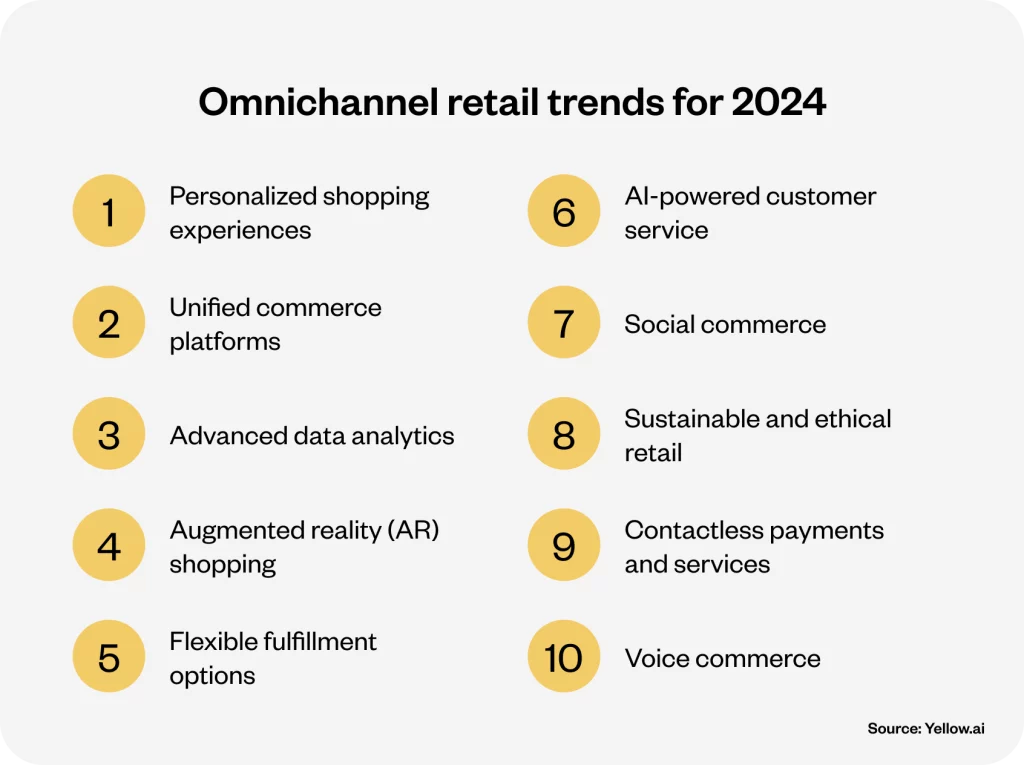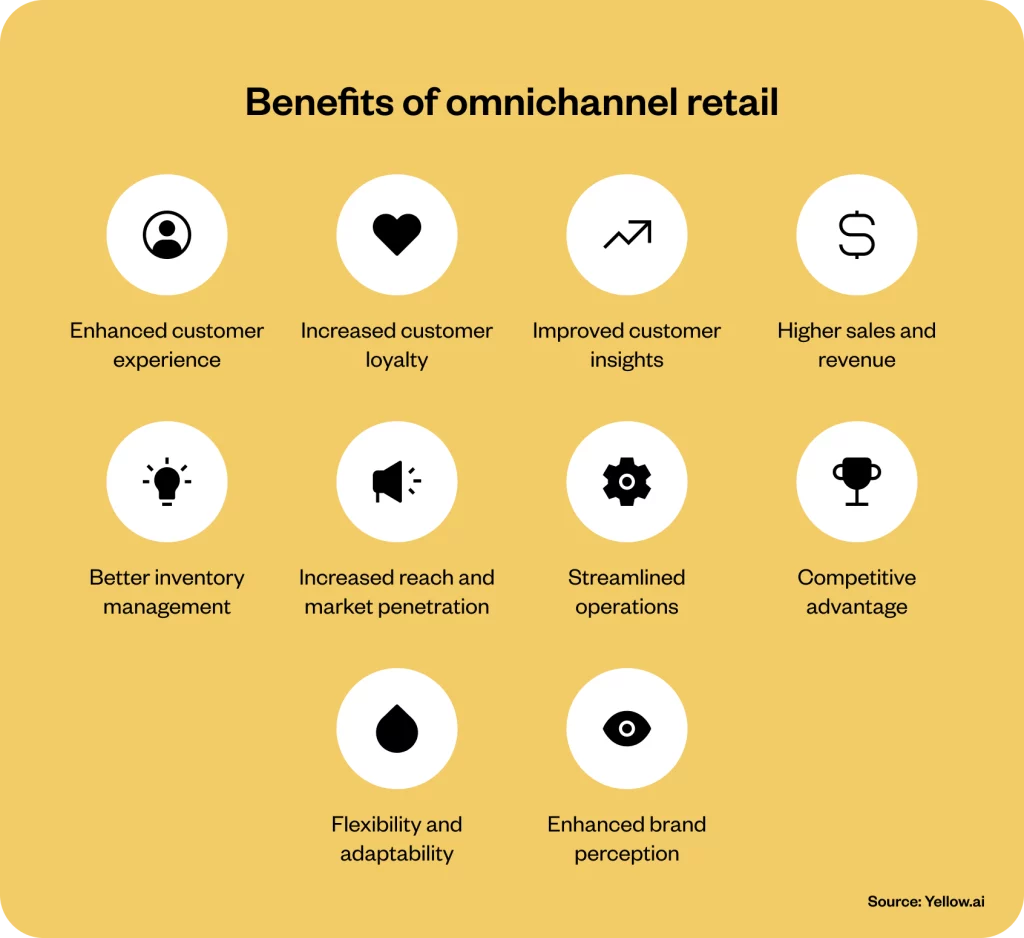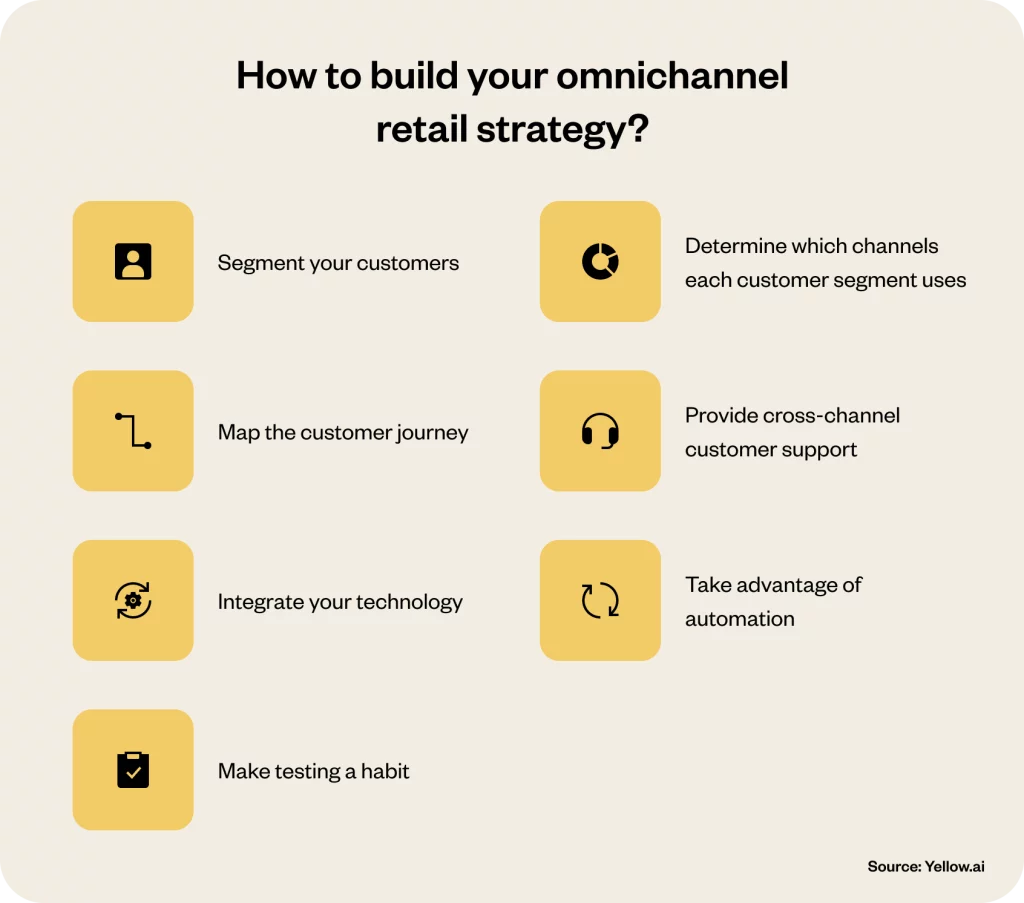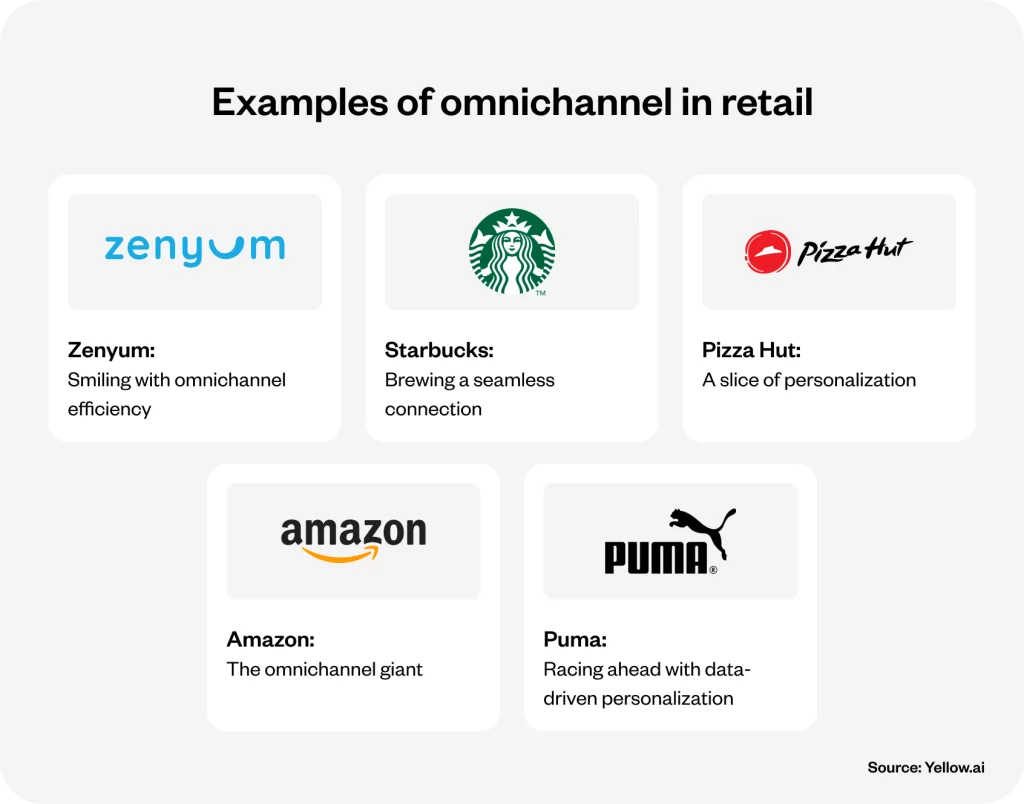Executive summary
Omnichannel retail is transforming shopping into a seamless experience that spans online and physical spaces. This blog unfolds the omnichannel retail strategy—its definition, impactful examples, and the latest trends. It highlights how this approach exceeds customer expectations by merging the convenience of online shopping with the tangible benefits of in-store experiences. For businesses aiming to thrive in the digital era, embracing omnichannel retail is not just an option but a necessity.
Introduction
Imagine a shopping world where your online cart and in-store wishlist are the same, where the digital and physical realms of retail don’t just meet but merge. It is the heart of omnichannel retail. With 58% of consumers poised to shop more online post-pandemic and 85% of UK shoppers in 2019 still cherishing the in-store experience, the call for a unified shopping journey has never been louder. Omnichannel retail answers this call, ensuring that whether you’re swiping on a screen or strolling through aisles, your shopping experience is consistently delightful.
In today’s retail landscape, the line between online and offline shopping blurs, creating a customer journey that is flexible, intuitive, and, above all, centered around consumer preferences. This blog ventures into the omnichannel universe, exploring how it’s reshaping retail by providing a cohesive customer experience across all channels. From leveraging AI to predict your next must-have purchase to offering pick-up options that fit into your day, omnichannel retail is about meeting you, the customer, wherever you are.
What is omnichannel retail?
Omnichannel retail is all about making shopping effortless and enjoyable, no matter where or how a customer chooses to shop. It’s a strategy that ties together the online and offline worlds, ensuring that whether a customer is tapping on their smartphone or wandering through aisles, they get a consistent and personalized shopping vibe. This approach lets shoppers jump from web to store to app as smoothly as flipping through the pages of their favorite magazine, with their preferences and past shopping adventures guiding the way.
Related read: Everyone deserves AI-enabled personal shopping assistants
Why is this essential for businesses? In the digital age, customers are kings and queens of their shopping kingdom, expecting to be known and catered to across all channels. They might spot something they love on Instagram, check it out on a website, and then swing by a store to grab it. Omnichannel retail makes this journey not just possible but seamless. It’s about knowing your customer so nicely that whether they’re online, on their phone, or in your store, you’re offering them what they want, often before they even ask.
Companies are embracing omnichannel retail for its transformative impact. This approach elevates customer loyalty, enhances sales, and streamlines operational hurdles, ensuring products are precisely positioned to meet demand. It’s a mutually beneficial scenario: shoppers enjoy a tailored and effortless shopping journey, akin to a bespoke concierge service, while companies witness tangible growth. The pivot to omnichannel retail marks a new era in commerce, merging technology with personal touch to revolutionize the shopping experience.
The future of omnichannel in retail
The future of omnichannel retail is a journey towards unprecedented convenience and personalization, seamlessly merging digital experiences with physical interactions. As we gaze into the retail horizon, it is evident that customer expectations are leaping toward a future where the distinction between online and offline shopping vanishes. The call for omnichannel excellence is no longer a whisper but a resounding demand. It is pushing retailers to innovate continuously.
Omnichannel retail is poised to redefine the shopping experience by integrating transformative technologies such as augmented reality (AR), artificial intelligence (AI), and cloud computing. These innovations are foundational shifts that enable retailers to create immersive, personalized shopping journeys.
Imagine walking into a store where AR mirrors let you try on clothes without changing or AI recommendations guide your purchase decisions based on your shopping history and preferences. It is the future where technology anticipates your needs and offers a shopping experience that’s delightfully satisfying and surprising.
Moreover, the data-driven backbone of omnichannel retail will empower retailers to understand their customers like never before. With advanced analytics, businesses can uncover trends, predict behaviors, and tailor their offerings to meet the nuanced demands of their customers. This level of insight will be crucial as retailers navigate the post-cookie world, where traditional methods of tracking and targeting become obsolete.
The future belongs to those who leverage their data wisely, creating value for their customers while respecting their privacy. As we move forward, the retailers who thrive will be those who view technology as an integral part of their brand identity. It will seamlessly blend innovation with the human touch to create shopping experiences that are memorable events.
Omnichannel retail trends for 2024
The omnichannel strategy in retail is revolutionizing how businesses interact with their customers. With 2024 on the horizon, let’s unpack the trends that are set to redefine the retail landscape. Knowing these trends will ensure that your business is not just keeping pace but is steps ahead in delivering exceptional customer experiences.

Related read: Retail customer service – tips & examples
1. Personalized shopping experiences
The era of one-size-fits-all is long gone. In 2024, expect hyper-personalized shopping experiences where AI and data analytics craft individual customer profiles to tailor product recommendations, offers, and content. It will make every shopping journey as unique as the customer itself.
2. Unified commerce platforms
Silos are breaking down, giving way to unified commerce platforms that integrate sales, marketing, and customer service. Seamless interactions across all channels, be it online, in-app, or in-store, mean customers can switch between channels effortlessly, maintaining continuity in their shopping experience.
Related read: 10 Best ecommerce platforms for your business in 2024
3. Advanced data analytics
Data is the new gold in omnichannel retail. Advanced analytics tools can give deeper insights into customer behavior, preferences, and trends. It will enable retailers to predict customer needs, optimize inventory, and personalize marketing efforts more effectively than ever before.
Related read: Top 10 data analytics trends to boost your business
4. Augmented reality (AR) shopping
Augmented reality takes the online shopping experience to another level. In 2024, AR will allow customers to visualize products in their own space and comfort before making a purchase, whether it’s trying on clothes virtually or seeing how a new sofa fits in their living room.
5. Flexible fulfillment options
Flexibility is key to fulfillment. Customers expect various options that suit their convenience, from same-day delivery to buy-online-pick-up-in-store (BOPIS) and curbside pickups. Retailers will need to adapt their logistics to offer these flexible options without compromising efficiency.
6. AI-powered customer service
AI will continue transforming customer service, with chatbots and virtual assistants providing instant, 24/7 support. These AI solutions will become more sophisticated, handling complex queries with ease and personalizing interactions based on the customer’s history and preferences.
Related read: AI chatbot – A complete guide for [2024]
7. Social commerce
Shopping on social media platforms is set to grow. With integrated “buy now” features and shoppable posts, customers can make purchases directly through social media, blurring the lines between browsing and buying and making every interaction an opportunity to shop.
8. Sustainable and ethical retail
Consumers are increasingly becoming conscious of their ecological footprint. It is driving demand for sustainable and ethically sourced products. Retailers must share their practices transparently and offer products that align with these values to stay relevant.
9. Contactless payments and services
The demand for contactless transactions, driven by health concerns and the need for convenience, will continue to rise. Retailers will expand their contactless payment options and services, making shopping safer and more streamlined.
10. Voice commerce
Voice-activated shopping is on the rise. As smart speakers and voice assistants are gaining incredible popularity, shopping through voice commands will become more common, offering a hands-free, hassle-free shopping experience.
Benefits of omnichannel retail
In the dynamic world of retail, adopting an omnichannel approach isn’t just an upgrade—it’s a revolution. Here’s how this strategy is changing the game for businesses and customers alike:

1. Enhanced customer experience
Businesses often find themselves struggling with the challenge of keeping pace with evolving customer expectations. However, omnichannel retail bridges the gap between digital and physical shopping, offering a unified experience. Customers no longer differentiate between online and offline – they seek excellence across all platforms. By meeting customers where they are, businesses can foster a seamless journey from screen to store. That enhances the overall customer experience.
2. Increased customer loyalty
Cultivating lasting customer relationships is vital for businesses. Personalized experiences and consistent quality across all channels naturally lead to deeper customer loyalty. Customers who feel understood and valued tend to stick around regardless of how they interact with your brand. This loyalty translates into a more robust bottom line, proving that good service is the best business strategy.
3. Improved customer insights
Gleaning actionable insights from customer data is the secret sauce for business success in this digital world. The omnichannel approach generates a wealth of data across touchpoints. By analyzing this data, businesses can unlock insights into customer preferences and behaviors. It allows businesses to make smarter, data-driven decisions that keep them ahead of the curve.
4. Higher sales and revenue
Boosting sales in a competitive landscape is a challenge almost every business faces. Offering multiple integrated shopping and engagement channels, omnichannel retail taps into increased spending potential. Customers who enjoy a frictionless shopping experience across platforms are shown to spend more, driving higher sales and revenue.
5. Better inventory management
Streamlining inventory across various channels can become a challenging task for retail businesses. Omnichannel retail solves this challenge with ease. Real-time inventory management becomes a breeze with omnichannel strategies. This efficiency reduces overstock and stockouts, ensuring customers find what they need when they need it, which, in turn, supports sales and customer satisfaction.
6. Increased reach and market penetration
Expanding your market presence in this digital-first world is a necessity. Omnichannel retail opens new avenues to reach customers, from social media to in-app purchases. It broadens your market footprint and attracts a diverse customer base.
7. Streamlined operations
Optimizing operational efficiency is the linchpin of any successful retail business. Integrating and automating processes across channels streamlines operations, enhancing productivity and reducing costs. This operational agility allows businesses to focus on growth and innovation.
Unify your CX with omnichannel AI automation

8. Competitive advantage
Standing out in a saturated market is a core area of focus in today’s retail business meetings. Offering a superior omnichannel experience positions your brand as a leader. It differentiates you from competitors and captures the attention of discerning customers.
9. Flexibility and adaptability
Keeping pace with market changes is also crucial. An omnichannel approach equips businesses with the agility to quickly adapt to market trends and customer expectations. That ensures long-term relevance and success.
10. Enhanced brand perception
Businesses continuously work to build a positive brand image. The omnichannel approach helps here as well. Businesses that successfully implement an omnichannel strategy are seen as customer-centric and innovative. It enhances overall brand perception and loyalty.
How to build your omnichannel retail strategy?
In today’s retail landscape, creating a cohesive omnichannel strategy is a necessity for connecting with customers across multiple touchpoints. This section delves into practical steps for building an omnichannel retail strategy that resonates with your business objectives and customer needs.

1. Segment your customers
The first cornerstone of a robust omnichannel strategy is understanding who your customers are. Segmentation allows you to categorize your audience based on various attributes such as demographics, purchasing behavior, and engagement preferences. It enables personalized communication and tailored shopping experiences.
Related read: Customer segmentation: The ultimate guide
Implementation tips
- Utilize CRM tools to analyze customer data and identify distinct segments.
- Consider factors like purchasing habits, product preferences, and engagement channels to create meaningful groups.
2. Determine which channels each customer segment uses
Recognizing that different customer segments may engage with your brand through various channels is crucial. Identifying and prioritizing these channels allows you to meet your customers where they are most comfortable and engaged.
Implementation tips
- Conduct surveys or analyze customer interaction data to understand channel preferences.
- Prioritize your investment in channels that align with the preferences of your most valuable segments.
3. Map the customer journey
A comprehensive customer journey map outlines every interaction a customer has with your brand, from initial awareness through to purchase and post-purchase support. It highlights critical touchpoints where personalized engagement can elevate the customer experience.
Related read: Benefits of customer journey mapping
Implementation tips
- Collaborate with teams across your organization to ensure a comprehensive view of the customer journey.
- Use real customer feedback and data to validate and refine your journey map.
4. Provide cross-channel customer support
Consistent, high-quality customer support across all channels strengthens customer trust and loyalty. Ensuring customers receive the same level of service online, in-app, and in-store is non-negotiable in an omnichannel strategy.
Implementation tips
- Implement a unified customer service platform that integrates all channels, allowing for easy transfer and tracking of customer inquiries.
- Train your support team to deliver personalized assistance, leveraging customer history and preferences accessible across all channels.
5. Integrate your technology
A cohesive technology stack that connects your e-commerce platform, CRM, inventory management, and customer support systems is crucial for delivering a unified customer experience.
Implementation tips
- Choose technology solutions that offer integration capabilities with your existing systems.
- Regularly review and update your tech stack to ensure it meets evolving business needs and customer expectations.
6. Take advantage of automation
Strategic use of automation can significantly enhance both operational efficiency and customer engagement. Automated systems can handle repetitive tasks, freeing up your team to focus on high-value activities and deliver personalized customer interactions at scale.
Implementation tips
- Implement chatbots for 24/7 customer inquiries and basic support tasks.
- Use email automation tools to send personalized product recommendations and offers based on customer behavior.
7. Make testing a habit
Ongoing testing and optimization are essential for maintaining an effective omnichannel strategy that evolves with customer expectations and market dynamics.
Implementation tips
- A/B test different aspects of your omnichannel strategy, from marketing messages to website design, to identify what works best.
- Use customer feedback and performance data to inform your testing hypotheses and adjustments.
Examples of omnichannel in retail
In the swiftly evolving retail landscape, businesses are increasingly adopting omnichannel strategies to provide seamless shopping experiences. Here, we delve into real-world examples of companies that have successfully implemented omnichannel retailing, setting benchmarks for customer engagement and operational excellence.

Zenyum: Smiling with omnichannel efficiency
Zenyum, a dynamic player in Southeast Asia’s healthcare tech sector, exemplifies omnichannel success. Facing the challenge of managing extensive customer interactions across varied channels, Zenyum harnessed the power of Yellow.ai to introduce a virtual assistant that operates seamlessly on their website, Facebook Messenger, Instagram, and WhatsApp. This AI-driven approach not only personalizes customer experiences at scale but also mirrors human-like interactions, enhancing engagement without the constant need for human intervention.
The results speak volumes: over 12,000 new users engaged through these channels within a year, showcasing the virtual assistant’s capacity to handle significant interaction volumes while maintaining a personalized touch.
Starbucks: Brewing a seamless connection
Starbucks, renowned for its coffee and customer service, leverages omnichannel retailing to enhance its customer loyalty program. By integrating their physical cards and mobile app, Starbucks enables customers to earn rewards, order ahead, and enjoy music playing in-store, among other features. This cohesive experience fosters a sense of loyalty and convenience, reinforcing Starbucks’s position as an omnichannel leader.
Pizza Hut: A slice of personalization
Pizza Hut UK tackled the common issue of one-dimensional email communications by adopting a customer-centric omnichannel approach. By soliciting first-party data through a welcome campaign, Pizza Hut gained valuable insights into customer preferences, enabling them to personalize the customer journey effectively. Their efforts in loyalty campaign personalization, powered by Emarsys, significantly boosted customer engagement, demonstrating the impact of a well-orchestrated omnichannel strategy.
Amazon: The omnichannel giant
Amazon’s customer-centric approach is exemplified by its omnichannel strategy. By leveraging extensive customer data, Amazon offers a shopping experience that is both personalized and convenient, allowing customers to shop on their own terms. The introduction of Amazon Prime, addressing the barrier of shipping costs, further underscores their commitment to removing friction from the shopping process, proving the value of understanding and acting on customer insights.
Puma: Racing ahead with data-driven personalization
Puma’s omnichannel approach reshaped its marketing strategy from mass newsletters to targeted, personalized communications. By unifying its customer data, Puma was able to segment its audience effectively and tailor its marketing efforts, resulting in significant improvements in revenue, engagement, and database growth. This transformation highlights the importance of data in crafting personalized customer journeys.
Create an omnichannel retail experience for your brand today.
As we delve into the realm of retail transformation, it’s crucial to spotlight the essence of a genuinely unified shopping experience attainable using futuristic technology. That is where Yellow.ai steps in, bridging the gap between potential and performance in the omnichannel landscape. It has been pioneering excellent automation in customer service for brands across industries with a multipronged approach. Yellow.ai’s platform is engineered to revolutionize how businesses connect with their customers across any channel, ensuring a harmonious and personalized retail journey from start to finish. For example, consider using our multilingual Dynamic Platform Automation or DAP, which helps slash expenses by as much as 60%. With it, you can support your customers 24/7 and respond to their queries instantly via their preferred channels.
Key features:
- Omnichannel integration: Seamlessly connect with customers across web, mobile, social media, and in-store channels, providing a consistent experience everywhere.
- AI-powered chatbots: Deploy intelligent chatbots across your website, social media platforms, and messaging apps to engage customers 24/7.
- Personalized customer interactions: Utilize machine learning to analyze customer behavior and tailor interactions for a more personalized shopping journey.
- Thorough product tracking: Offer your consumers a seamless retail experience that includes real-time information on product delivery progress and tracking at every stage.
- Seamless integration: Yellow.ai’s chatbots easily integrate with your existing CRM, e-commerce platforms, and inventory management systems, ensuring a unified brand experience.
- Real-time analytics: Gain insights into customer preferences and behaviors with advanced analytics, enabling data-driven decisions to enhance the retail experience.
- Multilingual support: Break language barriers and connect with a global customer base with chatbots that communicate in over 135 languages and dialects.
Ready to elevate your retail strategy?

The final thoughts
The journey through the evolving landscape of omnichannel retail unveils a future where boundaries between digital and physical shopping dissolve. It is a future where technology like Yellow.ai anticipates the needs of businesses and empowers them to meet customers with unparalleled precision and personalization. In this era, the commitment to an omnichannel approach transcends trends—it becomes the cornerstone of thriving retail. As we embrace these transformative solutions, we open doors to new possibilities, forging deeper connections and crafting experiences that resonate with every customer touchpoint. The path is clear; the time to act is now. Let’s navigate this journey together, redefining retail with every step forward.
Frequently asked questions (FAQs)
What is an omnichannel retailing strategy?
An omnichannel retailing strategy integrates multiple methods of shopping available to consumers, such as online, in-store, and through mobile devices. This approach provides a cohesive customer experience, ensuring consistent interaction and personalized engagement across all platforms.
How can an omnichannel strategy improve my operations?
Implementing an omnichannel strategy streamlines operations by unifying sales and marketing efforts, improving inventory management, and providing detailed insights into customer behavior. This holistic view enables businesses to optimize their processes, enhance customer satisfaction, and increase efficiency.
Is omnichannel the future of retail?
Yes, omnichannel is widely regarded as the future of retail. It aligns with evolving consumer expectations for seamless, personalized shopping experiences across multiple channels, driving engagement, loyalty, and sales.
Who is the best omnichannel retailer?
Several brands excel in omnichannel retail, such as Amazon, Starbucks, and Zara, each offering a unique and seamless shopping experience that effectively integrates their online and offline presence.
What is the difference between omnichannel and multichannel?
The key difference between multichannel and omnichannel lies in integration and customer experience. Multichannel retail involves using multiple channels to engage customers, often operating in silos. Omnichannel retail, however, ensures these channels are fully integrated, providing a unified, seamless customer experience regardless of the platform or device used.


























